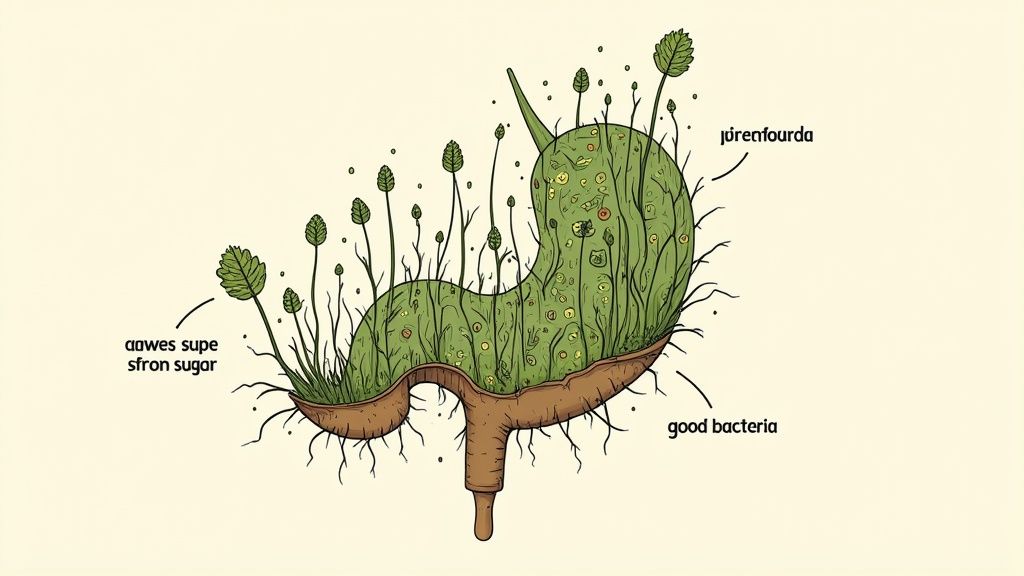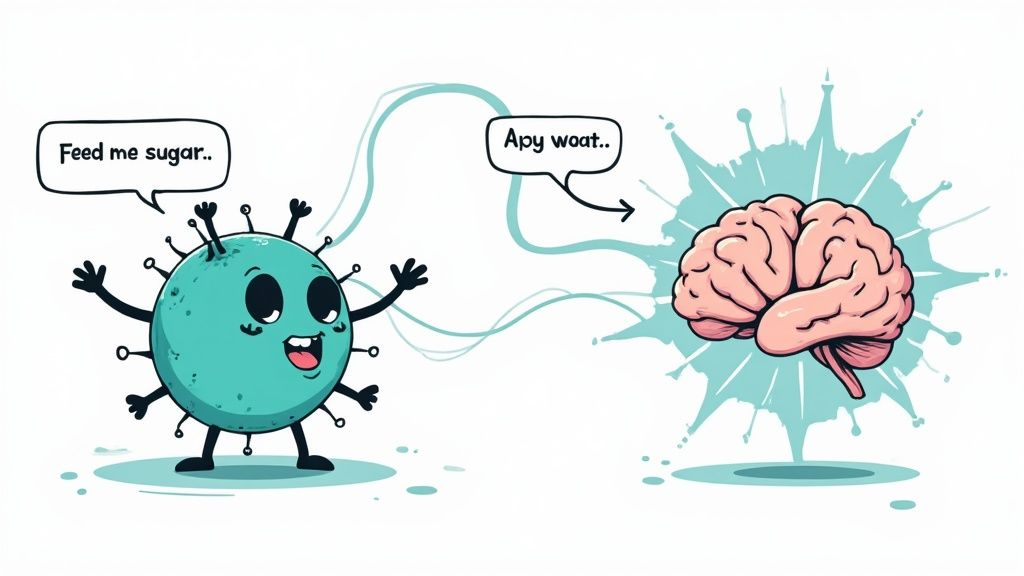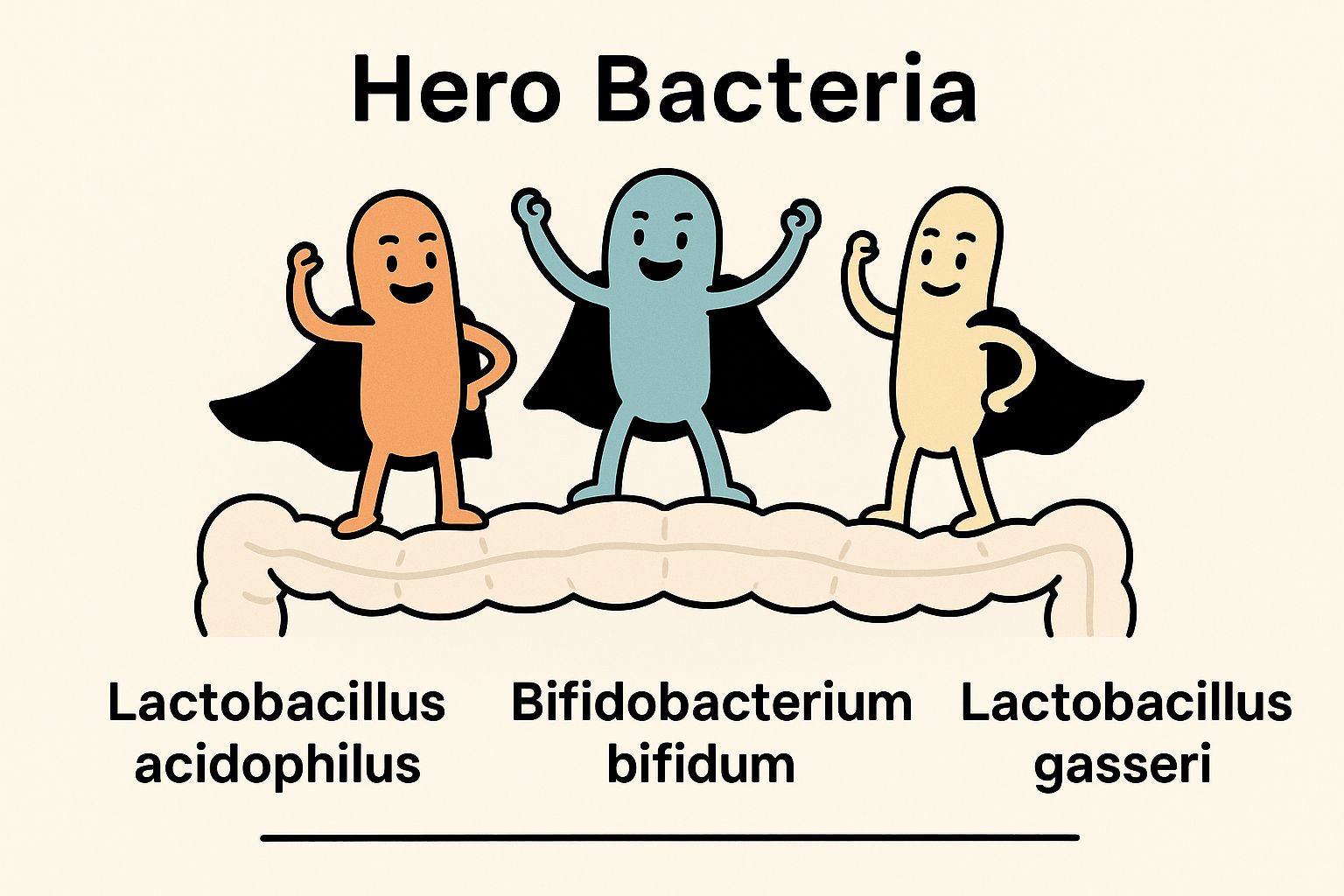Probiotics and Sugar Cravings: Your Gut's Secret Weapon

Ever feel like you’re locked in a losing battle with your sugar cravings? It can feel like a constant test of willpower, but what if the real fight isn’t in your head? What if it's happening deep inside your gut? Emerging science is revealing a fascinating connection between probiotics and sugar cravings, and it turns out, a healthy gut might just be the ally you've been looking for.
Your Gut Is the Real Boss of Your Cravings

Let's be honest, we’ve all blamed ourselves for caving and grabbing that extra cookie. But the truth is way more interesting than a simple lack of discipline. It has almost everything to do with the bustling community of trillions of microbes living inside you—your gut microbiome.
Think of your gut as a garden. If it gets overrun with weeds, which in this case are harmful, sugar-loving bacteria, they start sending some seriously strong signals to your brain. They’re demanding their favorite food: sugar. This isn’t a gentle nudge; it’s a biological command that can feel impossible to ignore.
The Gut-Brain Conversation
This constant chatter between your gut and your brain travels along a direct communication highway called the vagus nerve. When your gut microbiome is out of whack—a condition called dysbiosis—the "bad" bacteria can hijack this line. They start sending messages that crank up your desire for sweets.
This microbial meddling sets off a chain reaction:
- Intensified Cravings: Microbes that feast on sugar release chemical signals that make you want more and more of it.
- Mood Swings: An unhealthy gut can mess with the production of feel-good chemicals like serotonin and dopamine, leaving you reaching for sugar for a quick, temporary lift.
- Hormonal Havoc: Dysbiosis can throw off the hormones that control hunger, making it tough to feel full and satisfied after a meal.
It's a vicious cycle. The more sugar you eat, the more you feed the bad bacteria. The stronger they get, the louder they scream for more sugar. This feedback loop can feel impossible to escape.
The good news? You can change the conversation. By cultivating the "good" bacteria—the healthy, flourishing plants in your gut garden—you can start to restore balance. This is where probiotics come in.
By introducing beneficial microbes, you help crowd out the noisy, sugar-hungry ones. Their demands quiet down, and you get back in the driver's seat. Those cravings that once felt like an urgent shout eventually become a manageable whisper. If you want to dive deeper into the brain's side of the story, our guide on what is dopamine addiction breaks it down further.
How Your Gut Bacteria Secretly Fuel Your Sugar Habit

It sounds a bit like science fiction, doesn't it? The idea that tiny, unseen microbes living inside your gut could actually be controlling your food choices. But it's true. When your diet is heavy on sugar and processed foods, you’re essentially rolling out the red carpet for certain microbes, like the yeast Candida, that absolutely love the sweet stuff.
These little critters aren't just along for the ride. To keep their food supply coming, they send out chemical signals that mess with your mood and, you guessed it, trigger powerful cravings for their favorite meal: sugar.
The Gut-Brain Connection: Who's Really in Control?
Imagine your gut and brain are constantly on the phone. This line of communication is a real thing, known as the gut-brain axis. A major part of this network is the vagus nerve, which acts like a direct superhighway connecting the two.
When the sugar-loving bacteria in your gut get hungry, they use this highway to send an urgent message straight to your brain. The message is simple: "Feed me sugar, and do it now!"
These microbial demands can even influence your neurotransmitters, making you feel anxious or down until you finally give in and eat that cookie. That’s why a sudden, overwhelming urge for a donut can feel less like a simple craving and more like a desperate, undeniable need. It's a biological command, not a character flaw.
Realizing this can be a huge relief. Your sugar cravings aren't just a matter of willpower. They’re a sign that your inner ecosystem—your gut microbiome—is out of whack and calling for help.
This is exactly where the link between probiotics and sugar cravings becomes so important. By introducing beneficial bacteria, you start to push out the sugar-demanding microbes. It’s like changing the station from a loud, frantic broadcast to a calm, balanced one. When the good guys are in charge, the messages your brain receives are focused on health, not a quick sugar hit.
Your Gut’s Surprising Influence on Your Brain
Scientists are digging into this connection more and more, and the findings are fascinating. Probiotics don’t just stay in the gut; their effects reach all the way to your brain. One study, for example, showed that taking certain probiotics actually changed the activity in brain regions that handle food motivation and reward, helping to dial down the intense desire for sugary foods. You can dive deeper into these findings on gut-brain interactions.
This gut-brain conversation also plays a huge role in your hormones, especially insulin. An unhealthy gut microbiome thriving on sugar often leads to chaotic blood sugar levels, creating a vicious cycle of more cravings. You can learn more about this in our guide explaining what causes insulin spikes. By bringing your gut back into balance with probiotics, you help stabilize your blood sugar and break the craving cycle right at its source.
Meet the Probiotic Strains That Fight Cravings
It’s one thing to know that your gut bacteria can steer your cravings, but it’s another to know which specific microbes to get on your side. Not all probiotics are the same. Some are absolute superstars when it comes to the battle against sugar.
Think of these strains as your gut’s personal trainers—each one skilled at restoring balance and turning down the volume on those relentless calls for sweets. When you know which strains do what, you can walk down the supplement aisle with confidence. You’re no longer just grabbing a bottle labeled "probiotics"; you’re picking the right allies for the job.
This infographic breaks down three of our bacterial heroes, each with a unique talent for helping you get a handle on sugar.

As you can see, each of these microscopic helpers plays a vital part in building a gut environment that keeps cravings in check.
The A-Team of Probiotic Strains
Let's dive deeper into the key players and their unique superpowers in the fight against sugar. Time and again, certain bacterial families—especially Lactobacillus and Bifidobacterium—pop up in research for their standout ability to improve gut health and, by extension, help manage cravings.
Here are a few you should get to know:
- Lactobacillus acidophilus: This is probably the most famous probiotic of the bunch. It works by producing lactic acid, which creates an environment where those pesky, sugar-loving microbes just can't flourish. It essentially elbows out the bad guys.
- Bifidobacterium bifidum: Think of this strain as the guardian of your gut lining. It’s a champion at strengthening the intestinal barrier, which helps stop inflammatory compounds from leaking into your bloodstream—a process that can often trigger cravings.
- Lactobacillus gasseri: Studies have specifically connected this strain to better metabolic health and even weight management. It seems to have a direct line to the hormones that control your appetite and how you store fat, giving you a powerful way to manage hunger cues.
By looking for these specific strains, you're doing more than just hoping for the best. You're actively cultivating a gut microbiome that works with your health goals, not against them.
How These Strains Work Together
To make it even clearer, let's look at how these specific probiotics team up to tackle your sugar cravings at their source.
| Probiotic Strain | Primary Action | How It Helps with Cravings |
|---|---|---|
| Lactobacillus acidophilus | Competes with Harmful Bacteria | It takes up space and uses up resources, making it much harder for sugar-hungry microbes like Candida to overgrow and send those craving signals to your brain. |
| Bifidobacterium bifidum | Strengthens Gut Barrier | A healthier gut barrier means less system-wide inflammation. Since inflammation is a known trigger for hormonal imbalances that drive sugar cravings, this is a huge win. |
| Lactobacillus gasseri | Supports Metabolic Health | This strain helps fine-tune the hormones that tell you when you're hungry or full, leading to better appetite control and fewer moments of intense "I need sugar now!" panic. |
Of course, probiotics work best when they have the right support. Pairing them with the right diet is key. For more on this, check out our guide on foods that cut sugar cravings, which perfectly complement the work these beneficial microbes are doing.
Bringing Probiotics Into Your Daily Life
https://www.youtube.com/embed/G2CQlN7p1Os
Knowing the science behind probiotics and sugar cravings is one thing, but actually putting that knowledge to use is where the real change happens. Luckily, getting these helpful gut buddies into your daily routine is probably easier than you think.
You’ve got two main routes: eating more probiotic-rich foods or adding a high-quality supplement. The best approach is the one you can stick with, so let's find what works for you.
Boosting Your Intake Through Whole Foods
One of the tastiest and most natural ways to support your gut is to simply eat foods that are already packed with live cultures. Yogurt is the classic example, but the world of fermented foods is vast and delicious.
These aren't just vehicles for probiotics; they bring a host of other nutrients to the table, making them a true win-win for your health.
- Kefir: Think of this fermented milk drink as yogurt's supercharged cousin. It often boasts a wider variety of beneficial bacteria and has a tangy flavor that's perfect for smoothies.
- Sauerkraut: This fermented cabbage classic is loaded with Lactobacillus bacteria. Just make sure you grab the raw, unpasteurized kind from the refrigerated section to get the live and active cultures.
- Kimchi: A staple in Korean cuisine, this spicy, fermented mix of cabbage and other veggies adds a serious flavor and probiotic punch to everything from eggs to rice bowls.
- Kombucha: This bubbly fermented tea has become incredibly popular, and for good reason. My only tip here is to watch the sugar content—some brands can be surprisingly sweet.
You don't have to make massive changes overnight. Start by adding a spoonful of sauerkraut to your salad or a splash of kefir to your morning smoothie. These small, consistent habits really add up, helping to slowly shift your gut environment and dial down those intense sugar cravings. If you're feeling adventurous, exploring recipes for fermented vegetables is another fantastic way to introduce natural probiotics into your diet.
Choosing the Right Probiotic Supplement
While food is always a great starting point, supplements give you a more direct and targeted dose. They can deliver specific strains in high concentrations that are known to help with things like cravings.
But if you head down the supplement aisle, you'll see that not all probiotics are created equal. It pays to know what you're looking for.
When you're reading a label, there are two things to zero in on. First is the CFU (Colony Forming Units), which tells you how many live microbes are in each dose. For general gut health, a good starting point is a product with 10 to 50 billion CFUs.
Just as important is strain diversity. Look for a supplement that contains a mix of different strains, especially from the Lactobacillus and Bifidobacterium families. Think of it like building a well-rounded team—different players have different strengths, and having a variety gives you broader support.
A Winning Strategy for Lasting Sugar Control
Putting probiotics into your daily routine is a brilliant move, but they can't do the job alone. For them to truly flourish, you have to create an environment where they can thrive.
Think of it like planting a garden. You can have the best seeds in the world (the probiotics), but if you plant them in terrible soil, you won't get very far. To really win the war against sugar cravings, you need to cultivate rich, healthy soil in your gut.
This is where prebiotics come in. Prebiotics are essentially food for your good gut bacteria. They are specific types of fiber that act like a five-star meal for those beneficial microbes, helping them multiply and take over.
By adding prebiotic-rich foods to your diet, you’re not just introducing helpful bacteria; you’re feeding the army you already have so it can crowd out the sugar-loving microbes. It's a simple change that can create a massive shift in your gut's ecosystem.
Beyond Your Plate: The Other Gut Health Essentials
While what you eat is a huge piece of the puzzle, your gut health is about more than just food. A few other key lifestyle factors can either support your efforts or completely sabotage them. Ignoring them makes the fight against sugar cravings a whole lot harder.
Two of the biggest culprits? Stress and sleep.
- Chronic Stress: When you're constantly on edge, your body pumps out cortisol. This stress hormone can damage your gut lining and throw your microbiome into chaos, often triggering intense cravings for sugary "comfort" foods.
- Poor Sleep: Skimping on quality sleep messes with the hormones that control hunger and satiety, namely ghrelin and leptin. When they’re out of whack, you're almost guaranteed to face powerful cravings the next day, especially for quick energy hits like sugar.
A truly effective plan looks at the whole picture. It combines the power of probiotics, the gut-nourishing fuel of prebiotics, and smart lifestyle habits. This approach doesn't just put a band-aid on your cravings—it gets to the very root of the problem.
Creating Your Sustainable Plan
Building a gut-friendly lifestyle is how you achieve real, long-lasting control over sugar. It's about creating an internal environment where making healthy choices feels easy and natural, not like a constant struggle.
The science backs this up, with research showing that probiotics can positively influence sugar cravings by improving gut health and even changing how we perceive taste. If you want to dive into the nitty-gritty, you can learn more about these probiotic findings.
The key is to start small with changes you can stick with. Try adding some garlic or onions (fantastic prebiotics) to your dinner. Make it a priority to get an extra hour of sleep. Find a five-minute stress-relief practice that works for you. Each small step helps build a more resilient gut, putting you firmly back in the driver's seat.
Answering Your Top Questions About Probiotics and Cravings
Jumping into the world of probiotics can bring up a lot of questions. How long does it take? Can you get enough from food alone? Is it normal to feel a little... different at first?
Let's cut through the noise. Here are some straightforward answers to the questions I hear most often when it comes to taming sugar cravings with probiotics.
How Long Before Probiotics Actually Help My Sugar Cravings?
This is the big one, and the honest answer is: it depends. We're all different, and there’s no universal timeline.
You might notice some subtle, positive changes in your digestion and maybe even a slight dip in cravings within the first one to two weeks. But for the real, lasting impact, you need to be patient. Think more along the lines of one to three months.
It takes time for these new, beneficial bacteria to really settle in, multiply, and start influencing those powerful gut-brain messages that drive cravings. Consistency is everything—taking them daily is what gives them a fighting chance to make a difference.
Should I Get My Probiotics from Food or a Supplement?
Great question. The best approach is usually a bit of both.
Think of it as a two-part strategy. You can build a fantastic foundation by weaving more fermented foods into your daily meals.
- Food First: Things like kefir, kimchi, sauerkraut, and kombucha are amazing natural sources of live bacteria. Plus, they come packed with other nutrients that are great for your overall health.
- Targeted Support: This is where a high-quality supplement comes in. It's like calling in the specialists—you get a concentrated, guaranteed dose of specific strains, like Lactobacillus acidophilus and Bifidobacterium bifidum, that have been studied for their effects on cravings.
By eating fermented foods regularly and taking a targeted supplement, you give your gut the best of both worlds: a diverse community from food and a potent dose of the heavy hitters from the supplement.
Will I Have Side Effects When I Start Taking Probiotics?
It's pretty common to have a brief adjustment period when you first introduce a whole new army of bacteria to your gut. Don't worry, it's usually mild and short-lived.
For the first few days, some people experience a bit of gas, bloating, or a shift in their usual digestive rhythm. In most cases, this is actually a good sign! It means the new microbes are getting to work and your gut ecosystem is starting to rebalance.
To make the transition smoother, just start slow. Take a lower dose for the first week or two and gradually work your way up. This gives your system time to adapt. If any discomfort sticks around, it's always smart to check in with your doctor.
It’s no surprise that people are turning to gut health for answers. Over 70% of Americans now take dietary supplements, with probiotics being one of the most popular choices. It’s a clear sign that we're starting to understand just how much our gut influences our overall well-being. For a deeper dive, you can find more great insights on probiotic use from the National Institutes of Health.